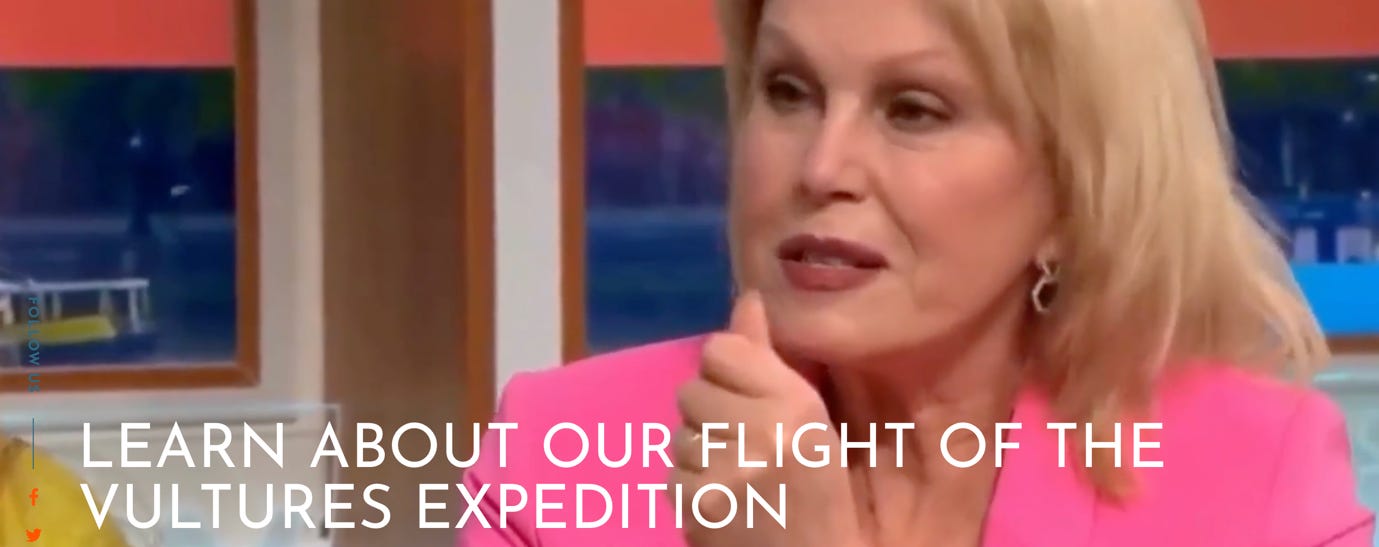Tomorrow's Chemistries And The Extinction Express
Thoughts catalyzed by visits this week to Vienna and a secretive Welsh vulture colony
It was the first time, I’m pretty sure, that I had enjoyed breakfast on the 57th floor of a skyscraper in Europe—with a panoramic view of Vienna and the Danube stretching off to either horizon. But I soon found myself distracted from the view by what had brought me to the city of Beethoven, Mozart and Freud in the first place.
And, as a result, I found myself pondering the chemical makeup of the water flowing by far below—and the lifetime environmental footprint of the skyscraper I now found myself sitting atop.
How much industrial chemistry, I wondered, had been involved in getting my fellow diners to that extraordinary height above the city—and keeping us safe, healthy, fed and watered once there? And how markets had mediated the relevant processes.
True, we no longer use materials like asbestos in such projects, but what out materials with toxicities through their life cycles do we use? And who keeps track, either with blockchain records or, more specifically, what some call “material passports”?
And just in case you are wondering what it was about that high-rise breakfast that had toxicology bubbled up quite so energetically in my brain, the answer can be spelled out in just five letters: SETAC. They stand for the Society of Environmental Toxicology and Chemistry.
Founded in 1979, this is now a global, non-profit organization with nearly 10,000 members—representing more than 3,400 organizations from across 130 countries. This year’s conference theme emphasized the need for integration of cutting-edge innovations with safety and sustainability considerations, through the implementation and expansion of the Safe and Sustainable (by Design) thinking.
The rising challenge of “polypharmacy”
While keynoting the opening session of SETAC’s annual event the previous day, May 11th, I reflected on likely directions in the evolution of “tomorrow’s chemistries.” In the process, I briefly mentioned my guilt about today’s chemistries as I swallow, every morning, half a dozen pills—including statins—to counter the risk of strokes.
As populations age, I noted, especially in high- and middle-income countries, we see rising rates of chronic illness (eg., diabetes, hypertension, arthritis, dementia), greater use of long-term treatments (eg., antibiotics, antidepressants, painkillers, and cardiovascular drugs), and increased so-called “polypharmacy”—where many older adults (including me) take five or more medications daily. Many of us following doctor’s orders.
The salmon and the Babel fish
By way of explaining my guilt, I observed that water worldwide is increasingly contaminated by pharmaceuticals—and by their breakdown products. Topically, I referenced recent research suggesting that salmon parr exposed to anti-anxiety drugs in rivers seem to benefit, with the resulting bolder fish more likely to make it back to the seas and oceans.
But one seemingly positive externality in no way compensates for all the negative externalities associated with our ever-growing use of increasingly sophisticated chemicals.
Later, in a rare quiet moment, I worked through the voluminous program for the event. Deep down, among hundreds of platform and poster sessions, I came across item 2.04.T-01: “Pharmaceutical Pollution Alters River-to-Sea Migration Success in Atlantic Salmon (Salmo salar),” by Michael Bertram of the Swedish University of Agricultural Sciences.
And this incidental stumbling across item 2.04.T-01 reminded me of Douglas Adams’ Hitchhiker’s Guide to the Galaxy, published the same year that SETAC was launched. There we learned that intergalactic plans for Earth’s destruction, of which we Earthlings had remained completely unaware, had been on display for no less than half a century.
We were chastised for ignoring the fact. As the somewhat irritated Protetnic Vogon Jeltz protested:
There’s no point in acting surprised about it. All the planning charts and demolition orders have been on display at your local planning department in Alpha Centauri for 50 of your Earth years, so you’ve had plenty of time to lodge any formal complaint and it’s far too late to start making a fuss about it now. … What do you mean you’ve never been to Alpha Centauri? Oh, for heaven’s sake, mankind, it’s only four light years away, you know. I’m sorry, but if you can’t be bothered to take an interest in local affairs, that’s your own lookout. Energize the demolition beams.
In much the same vein, it seems to me, the boards and C-suites of too many businesses remain sublimely unaware of the work being done by tens of thousands of scientists around the world on the impact of chemicals and chemistries—specifically their effects on both human health and the natural environment.
It did occur to me that perhaps what we need now is some version of Douglas Adams’ glorious invention, the “Babel fish”—a small, bright yellow fish, which can be placed in someone's ear so they can hear any language translated into their mother tongue.
Our writing on their wall
No-one mentioned their ambition to invent chemistry’s version of the Babel fish to serve the world’s boards, at least in my hearing. Still, one innovation SETAC launched this year was a “Wall of Ideas.” Hopefully it will have captured some leading edge thinking from delegates through the week. (Though the “Wall” was more the size of a whiteboard, so I felt obliged to write in a very small hand.)
SETAC also experimented with a “Meet & Greet” session, where I was the guinea pig speaker. A welcome opportunity to exchange thinking with experts from around the world. And among the ideas that came up both there and in the other sessions I took part in were:
The “Big 3”: Several speakers clustered chemicals alongside climate and loss of biodiversity as our central environmental challenges—with growing recognition that chemicals now increasingly drive biodiversity loss.
AI: Once again, this was a hot topic. Many researchers reported back on their progress to date, though some speakers warned that AI’s growing power should not blind us to the continuing need for humans in decision-chains. AI’s role is as a support not a substitute, as one put it.
Blind-spots: In a well-attended session on the role of chemistry in enabling the green transition, the top-ranked question on Mentimeter asked how we can avoid building our blind spots into large-language models (LLMs), something that can happen both with flawed and biased data.
The “biodiversity time machine”: Another concern was that biosphere-linked challenges often take decades, even centuries, to express themselves, necessitating planning and sustained action over timescales that are well beyond the reach of most businesses and governments today.
The growing challenge of “cocktails”: This one came up time and again, with real concern that chemicals entering the environment are currently investigated in isolation—whereas in the real world they often show up as part of more complex mixtures.
Beware “cocktails”
As I was limbering up for the event, as now seems customary in TV game shows, I called on a friend for advice. Professor Mike Depledge, CBE, FRS, to give him his due. I had first come across him in his role a board member at the Eden Project. But his work ranges much wider, as his Royal Society profile notes:
Michael Depledge is Emeritus Professor of Environment and Human Health and founder of the European Centre for Environment and Human Health, (University of Exeter). He is also a Fellow of the Royal College of Physicians and Honorary Professor of Public Policy at University College, London. From 2002-2006 he served as the Chief Scientific Advisor of the Environment Agency, later becoming a founding board member of Natural England (2006-9) and a member of the Royal Commission on Environmental Pollution (2006-11).
So, this seemed to me a reasonable place to start. And here’s some of what he then told me:
I’m keen to change the emphasis from focusing on exposure, to looking for effects in the real world. I think of it as the “Sherlock Holmes” approach. First detect early signs of disruption in our ecosystems, then track back to identify the causes and do something about them. This may seem a bit “after the event” but we’d be learning a lot about what can happen which I hope would lead before long to much more care and thought being put into managing anthropogenic chemicals in nature.
More specifically, he flagged the following concerns:
· Lab-based toxicity tests, involving just a handful of species, are used to assess individual chemicals—but are very poor predictors of chemical toxicity in diverse species in nature.
· In any case, only a tiny proportion of the 350,000 chemicals registered have been tested.
· That said, the huge variety of chemical mixtures discharged into the environment make it impractical to test the toxicity of all of them using the above tests.
· Exposures to mixtures of environmental chemicals tend arise spontaneously in ecosystems. Imagine a map of PFAS pollution around the UK. Then imagine a map of PCB pollution, pesticide pollution, pharmaceutical pollution, heavy metal pollution, and so on. There are bound to be hotspots where the highest concentrations of mixtures of these chemicals arise. But where are they and how can we detect their impact on biodiversity and human health?
· There is a widely held view that chemicals in mixtures exert their toxicity additives with very few synergistic effects. Personally, I think that conclusion is premature as only a small number (less than 100??) have been tested and then not in a sensible way.
At different times in Vienna, I heard linked concerns surface several times. All of which encouraged me to think slightly outside the box. I have long been fascinated to explore the museums maintained by major companies, sometimes spotlighting products and technologies that have turned out to be on the wrong side of history.
Museum of Extinct Chemistries
So, one idea I proposed in my keynote, and which seemed to have a certain resonance, was what I called a “Museum for Extinct Chemistries.” Here visitors would be able to explore the lives and deaths of a growing array of chemistries. I imagine displays of fossil chemistries.
My shortlist for the Museum in 2040 included:
Heavy metals (e.g., lead, mercury, arsenic)
Naturally occurring elements long used in a range of industrial processes. Exposure can lead to serious health issues, including neurological damage and organ failure. During the SETAC event, though I heard that even lead is still used in products like lipsticks today.
Phthalates and Bisphenols (e.g., BPA)
These have been a hot topic for a long time. Commonly found in plastics and personal care products, they are known endocrine disruptors. They can interfere with hormone function, leading to reproductive issues and developmental problems. Exactly the sort of issues I flagged in my 1985 book, The Poisoned Womb. Sometimes the speed of change can be glacial—a theme hammered by several SETAC veterans this week.
Flame Retardants (e.g., PBDEs)
Again, we have known about the issues here for ages. Used in furniture, electronics, and building materials, some flame retardants have been associated with neurodevelopmental deficits and thyroid hormone disruption.
Persistent Organic Pollutants (POPs)
These include chemicals like DDT and PCBs, banned or restricted in many countries but persisting in the wider environment.
PFAS (Per- and Polyfluoroalkyl Substances)
Again, a known problem, though the science has often been disputed by businesses with the most to lose, including 3M. Known for use in non-stick cookware, waterproof clothing, and firefighting foams, PFAS are highly persistent. They are linked to various health issues, including cancer and hormone disruption.
The Darth Vader of chemicals, Diclofenac
So, a question for you. What chemistries would you want to see confined to display cases in any such museum? And what sort of timescales would you set on the relevant extinction process?
One product that I would have high on my own shortlist would be Diclofenac, which I spotlighted in my keynote—at least where used to treat cattle with local vulture populations. First synthesized as recently as 1973, the drug has found widespread applications as a painkiller but has also had catastrophic effects in countries like India.
As the BBC reported last year:
Once upon a time, the vulture was an abundant and ubiquitous bird in India.
The scavenging birds hovered over sprawling landfills, looking for cattle carcasses. Sometimes they would alarm pilots by getting sucked into jet engines during airport take-offs.
But more than two decades ago, India’s vultures began dying because of a drug used to treat sick cows.
By the mid-1990s, the 50 million-strong vulture population had plummeted to near zero because of diclofenac, a cheap non-steroidal painkiller for cattle that is fatal to vultures. Birds that fed on carcasses of livestock treated with the drug suffered from kidney failure and died.
Since the 2006 ban on veterinary use of diclofenac, the decline has slowed in some areas, but at least three species have suffered long-term losses of 91-98%, according to the latest State of India's Birds report.
And that’s not all, according to a new peer-reviewed study. The unintentional decimation of these heavy, scavenging birds allowed deadly bacteria and infections to proliferate, leading to the deaths of about half a million people over five years, says the study published in the American Economic Association journal.
And it’s not as if no-one saw this coming. One friend, Pavan Sukhdev of GIST Impact, where I serve on the advisory board, warned the Indian government well in the early stages of the crisis.
The Extinction Express
On Tuesday, 13th May, I co-hosted (with Sacha Dench of Conservation Without Borders) a group of people mainly from the business world on a visit to an off-the-beaten track vulture colony in Wales.
The participants came from a wide range of organizations, including the Crown Estate, Deloitte, Ecosia, EDF, MacFarlanes, Nature Finance and Savill Earth Advisory. Judging from the feedback, interacting with a significant number of different vulture species converted many of us who had previously thought that these extraordinary birds lack charisma.
The theme of the trip, one of two on consecutive days, with the first co-hosted by Jennifer Saunders of Absolutely Fabulous renown, was the “Extinction Express.” This is I have used while working on my latest book, which looks at how our economies in general—and capitalism in particular—can become truly regenerative.
In what is increasingly known as the “Sixth Mass Extinction,” the background extinction rate is now 100 to 1,000 times faster than natural background rates. WWF's latest Living Planet report shows that monitored wildlife populations have declined by an average of 73% in just 50 years, my working lifetime.
Up to 1 million animal and plant species face extinction within decades. Every 1°C rise in global temperatures risks losing 5-10% of species. At current trajectories, global warming alone could cause 20-30% of species to go extinct by the end of this century.
And the Amazon rainforest, where I’m headed on Monday, loses 10,000 km² to deforestation annually. Scientists warn that it is nearing an irreversible tipping point where it could shift from rainforest to savannah, devastating global biodiversity.
Maybe we can work out how to run regular “Extinction Expresses,” to bring key decision-makers face-to-face with the bleeding edge of species loss—and the contributory causes? In doing so, we will likely need a twin-track approach.
The first—spotlighted by our first Extinction Express odyssey—should focus on the restoration and regeneration of ecosystems, while the second—spotlighted by the SETAC event—must focus on ensuring that tomorrow’s technologies and economies celebrate, value and actively concern biological and ecological diversity. Whatever height you look at all this from, it’s clear that neither will succeed without the other.
Acknowledgements: My warm thanks go to Professor Leo Posthuma of RIVM and Radboud University, where he is an extraordinary professor, and Professor Peter Fantke of Goethe University Frankfurt, for helping me shape my SETAC keynote. It wasn’t exactly a pearl, but it is always helpful to have a little friendly grit in the oyster. And at Conservation Without Borders I thank Sacha Dench and her extraordinary team.
John Elkington is Founder & Global Ambassador at Volans. His personal website can be accessed here. His latest book is Tickling Sharks: How We Sold Business on Sustainability (Fast Company Press, 2024). Available on Amazon and through good bookshops:
What readers say:
“John is a legend. Throughout my 30-year career in sustainability leadership, he has been a source of insight and inspiration. By extension he has influenced the thinking of thousands of senior executives on our programmes. This book offers a wonderful and personal reflection on the evolution of the sustainability movement and glimpses of what might be to come.”
DAME POLLY COURTICE, founding director, Cambridge Institute for Sustainability Leadership (CISL)










Hi John, I wonder if you've investigated the impact of flea, lice, tick and worm treatment in pets? I was struck by Dave Goulson's warnings in his book, Silent Earth - An insect Apocalypse, about the huge impact on bees of flea treatments. In particular spot on treatments which easily get into waterways. I'm in a continual dilemma about what approach to take and have reached the conclusion that I'm not going to use ongoing preventative treatment, but treat the problem if it arises. This has been working well so far..... x
An invaluable and incisive post - many thanks. Much of the work that I'm engaged with is focused on how we might get to consciously choose what we recognise, respond to and get ready for. Currently, as we both know, we're ready to board the 20.35 Extinction Express from all major stations, yet unable to recognise or respond to the patterns that bought us our ticket. Our working thesis is that if 1: 100 citizens had the experience and skills to hold Three Horizons conversations in their work places or communities, and 1:5 young people had the insight and confidence to ask better questions and be 'first followers', there's a chance that we might reach a positive tipping point fast enough to avoid many of the worst outcomes that'll come our way if we don't change.